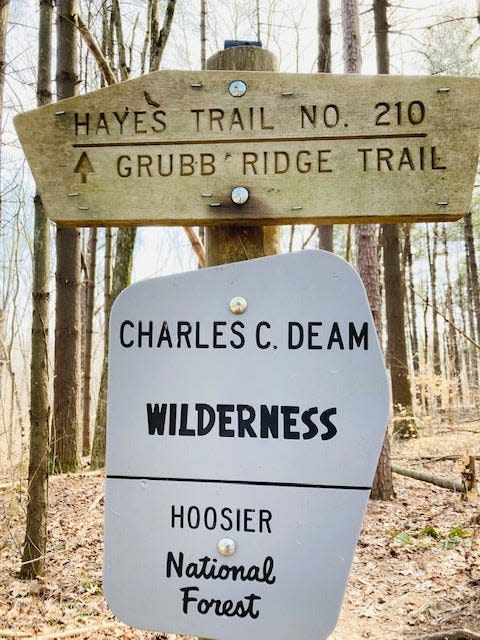A Hiker's Path: Spring wildflowers along the Hayes trail in Indiana's Deam Wilderness
Perhaps one of the lesser known trails in the Deam Wilderness section of the Hoosier National Forest is the Hayes trail. I recently hiked there and really enjoyed my time.
The Charles C. Deam Wilderness was designated by Congress as a wilderness in December 1982. It was named after the first state forester in Indiana, who was a pioneer in forest conservation and an author of books on the trees and flora of Indiana. Charles Deam traveled throughout the state and collected more than 78,000 plant specimens, discovering 25 new plant species.
He was largely responsible for initiating the state forest system we have today. The forest service acquired the first land now in the wilderness boundary in 1935 as abandoned, tax-delinquent farmland. The first priorities were to stabilize erosion, rehabilitate the damaged land, and control wildfires. With the Civilian Conservation Corps (CCC) program of the 1930s the Forest Service began reforesting the hillsides.
The Deam Wilderness encompasses over 13,000 acres of the larger Hoosier National Forest, which in total contains 202,814 acres. Within the Wilderness there are 37 miles of trails which allow for hiking and horseback riding.
It’s 37 miles of trail that I have come to love.

The trailhead for the Hayes trail is easy to access from the other side of the Deam Wilderness off Ind. 446 right on Hays Road. (The spelling of the trail and road are different).The trail is 2.5 miles in length and intersects with the Grubb Ridge loop that begins at Blackwell Horse Campground. This stand alone trail is worth a second glance.
It was a beautiful early spring day in Indiana when I hiked this trail. The air was still a bit chilly so I wore a jacket. I found the trailhead quite easily and took off down the trail to explore what the day had to offer.
The first thing I noticed were the early wildflowers growing along the sides of the path. “Spring Beauty,” one of the forest’s earliest spring flowers had appeared, dotting the landscape here and there.
There were also sightings of “Bloodroot,” another early sign of spring in the forest. I thought of Charles Deam as I photographed these plants. I could almost see him documenting them in an old “field note” journal. The thought brought a smile to my face as I continued along the old dirt path.

I soon started a descent down a rather steep trail. When I got to the bottom of the hill, there was a stream bed with a lot of rocks so I had to spend a few minutes exploring. Wildflowers and rocks! I was in my element!
The next section of the trail was an ascent of 250 feet to a high ridge. Once on top, I found a beautiful view of the valley below. The ridge paralleled the creek down in the valley.
After following the ridge for a short while, the trail dropped back into the valley and then, ascended again to the top of a beautiful ridge.
Here I found an abundance of Bloodroot. A member of the poppy family, the plant gets its name from the red juice found in its stem and roots. Native Americans used the juice as a dye for baskets and clothing and as an insect repellent. The beautiful white flowers fold up at night and unfold each day to bask in the sun’s light.
After this ridge, the trail went back into the valley where it intersected with the Grubb Ridge Trail. This is a good turnaround spot. If you continue on the trail, it will take you on a more rugged hike along the Grubb Ridge trail.
I opted to turn around.
I had taken quite a few photos and notes as well in the “field journal” of my mind. I would remember this place and return again someday.
It’s a nice hike in early spring with a few hills but it’s worth the effort. It’s really quite scenic.
To get to this place: From Bloomington, take Ind. 446 for approximately 10 miles (across the Lake Monroe causeway). Turn left onto Hays Road. Drive 1/10 of a mile to the trailhead and parking lot.A quote for your week: “We shall not cease from exploration, and the end of all of our exploring will be to arrive where we started and know the place for the first time.” — T. S. Eliot, poet, essayist, 1888-1965Until the next trail, Susan
This article originally appeared on The Herald-Times: Early spring wildflowers dot forest floor in Hoosier National Forest
